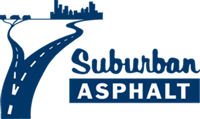- By Ron La Porte
- In Solutions
Asphalt Maintenance
 The start of the year is a perfect time to evaluate your asphalt maintenance plan at your facility. While this may seem like a daunting task and maybe something that one could afford to be put off, a little proactive planning can make the difference between a small nuisance and a big concern.
The start of the year is a perfect time to evaluate your asphalt maintenance plan at your facility. While this may seem like a daunting task and maybe something that one could afford to be put off, a little proactive planning can make the difference between a small nuisance and a big concern.
How Do I Start Planning an Asphalt Maintenance program?
There are several ways to start protecting your asphalt pavement and planning for the future. The best approach is to start by understanding the life cycle of an asphalt pavement section. The next part is a little tricky. This is where an evaluation of whether your asphalt requires maintenance, repair, or both. (A trained solution-focused expert is able to guide you through this process.) In conjunction, a thorough explanation of your options is necessary to determine the best direction for your asphalt pavement.
What Are the Asphalt Maintenance Options?
• Routing/Crack Sealing
• Seal Coating
• Asphalt Patching
• Mill/Pave
• Infrared Patching
Crack Sealing
Most often, crack sealing is the best option available to protect an asphalt pavement section. Doing so will prevent moisture from entering the sub-surface and weakening the structural integrity. That being said, if a virgin crack hasn’t been crack filled before, it is recommended to be routed beforehand, but only if you plan on sticking to a routine maintenance plan. Routing expands the crack making a larger gap where water can enter.
Seal Coating
Another option that is often taken is seal coating. This is a great aesthetic facelift to your asphalt and pavement protector.
Asphalt Patching
Asphalt patching is pretty common and is otherwise known as partial depth asphalt replacement because of the removal of just asphalt as opposed to the asphalt and underlying sub base. This should be done when an asphalt area contains a pothole, the cracks are wider than a ½”, or alligator cracking is prevalent.
Mill/Pave
Milling off an area of asphalt can be thought of as shaving an asphalt section down to a certain depth. A large machine known as a mill uses sharp teeth to puncture and grind the asphalt off. This is typically used in an asphalt overlay. Most often, this doesn’t fully repair the asphalt section, but does try and limit the amount of undercuts of unstable base if present.
Infrared patching
Infrared patching is the process of heating a damaged asphalt area and fusing it together with fresh asphalt. This is a less expensive fix and doesn’t have the longevity of some other options.
Summary
Take a good look at your asphalt. Any area that is questionable will only grow into a bigger problem as time continues. A proactive approach protects your investment and saves on larger repairs. Remember to don’ forget and protect your asphalt!
